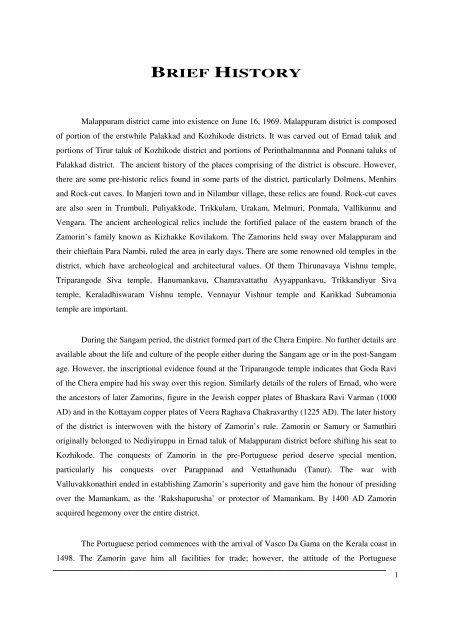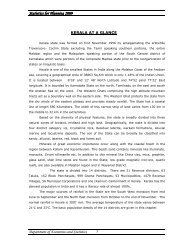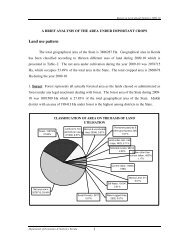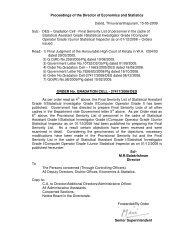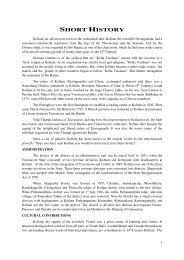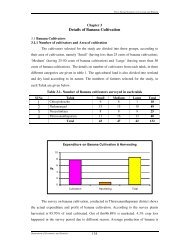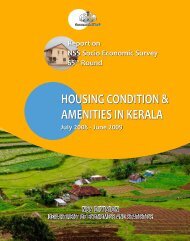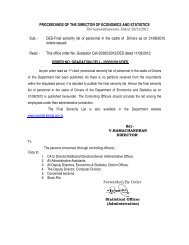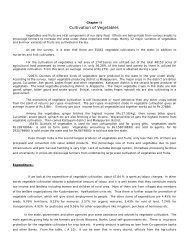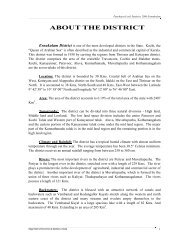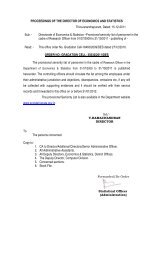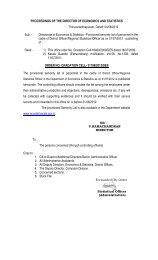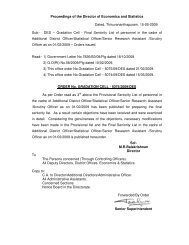BRIEF HISTORY - Government of Kerala
BRIEF HISTORY - Government of Kerala
BRIEF HISTORY - Government of Kerala
Create successful ePaper yourself
Turn your PDF publications into a flip-book with our unique Google optimized e-Paper software.
<strong>BRIEF</strong> <strong>HISTORY</strong><br />
Malappuram district came into existence on June 16, 1969. Malappuram district is composed<br />
<strong>of</strong> portion <strong>of</strong> the erstwhile Palakkad and Kozhikode districts. It was carved out <strong>of</strong> Ernad taluk and<br />
portions <strong>of</strong> Tirur taluk <strong>of</strong> Kozhikode district and portions <strong>of</strong> Perinthalmannna and Ponnani taluks <strong>of</strong><br />
Palakkad district. The ancient history <strong>of</strong> the places comprising <strong>of</strong> the district is obscure. However,<br />
there are some pre-historic relics found in some parts <strong>of</strong> the district, particularly Dolmens, Menhirs<br />
and Rock-cut caves. In Manjeri town and in Nilambur village, these relics are found. Rock-cut caves<br />
are also seen in Trumbuli, Puliyakkode, Trikkulam, Urakam, Melmuri, Ponmala, Vallikunnu and<br />
Vengara. The ancient archeological relics include the fortified palace <strong>of</strong> the eastern branch <strong>of</strong> the<br />
Zamorin’s family known as Kizhakke Kovilakom. The Zamorins held sway over Malappuram and<br />
their chieftain Para Nambi, ruled the area in early days. There are some renowned old temples in the<br />
district, which have archeological and architectural values. Of them Thirunavaya Vishnu temple,<br />
Triparangode Siva temple, Hanumankavu, Chamravattathu Ayyappankavu, Trikkandiyur Siva<br />
temple, <strong>Kerala</strong>dhiswaram Vishnu temple, Vennayur Vishnur temple and Karikkad Subramonia<br />
temple are important.<br />
During the Sangam period, the district formed part <strong>of</strong> the Chera Empire. No further details are<br />
available about the life and culture <strong>of</strong> the people either during the Sangam age or in the post-Sangam<br />
age. However, the inscriptional evidence found at the Triparangode temple indicates that Goda Ravi<br />
<strong>of</strong> the Chera empire had his sway over this region. Similarly details <strong>of</strong> the rulers <strong>of</strong> Ernad, who were<br />
the ancestors <strong>of</strong> later Zamorins, figure in the Jewish copper plates <strong>of</strong> Bhaskara Ravi Varman (1000<br />
AD) and in the Kottayam copper plates <strong>of</strong> Veera Raghava Chakravarthy (1225 AD). The later history<br />
<strong>of</strong> the district is interwoven with the history <strong>of</strong> Zamorin’s rule. Zamorin or Samury or Samuthiri<br />
originally belonged to Nediyiruppu in Ernad taluk <strong>of</strong> Malappuram district before shifting his seat to<br />
Kozhikode. The conquests <strong>of</strong> Zamorin in the pre-Portuguese period deserve special mention,<br />
particularly his conquests over Parappanad and Vettathunadu (Tanur). The war with<br />
Valluvakkonathiri ended in establishing Zamorin’s superiority and gave him the honour <strong>of</strong> presiding<br />
over the Mamankam, as the ‘Rakshapurusha’ or protector <strong>of</strong> Mamankam. By 1400 AD Zamorin<br />
acquired hegemony over the entire district.<br />
The Portuguese period commences with the arrival <strong>of</strong> Vasco Da Gama on the <strong>Kerala</strong> coast in<br />
1498. The Zamorin gave him all facilities for trade; however, the attitude <strong>of</strong> the Portuguese<br />
1
underwent radical changes resulting in conflicts with the Zamorin. Ponnani (which now forms part <strong>of</strong><br />
the district) also was an important target <strong>of</strong> the Portuguese. In 1507 Almeida raided Ponnani and<br />
started building a fortress there in 1585. By the close <strong>of</strong> the 16 th century, the Portuguese supremacy<br />
in the Malabar Coast started dwindling and it slowly declined giving political advantage to the Dutch.<br />
Unmindful <strong>of</strong> Portuguese opposition, the Zamorin entered into a treaty with the Dutch East India<br />
Company on 11 th November 1604. This was followed by another treaty in 1608, which confirmed the<br />
earlier treaty and the Dutch assured assistance to Zamorin in expelling the Portuguese. By the middle<br />
<strong>of</strong> the 17 th century, the Dutch had monopoly <strong>of</strong> the foreign trade in the <strong>Kerala</strong> coast except for small<br />
English factories at Ponnani and Calicut. The arrival <strong>of</strong> Captain Keeling at Kozhikode in 1650 and<br />
the conclusion <strong>of</strong> a treaty with the Zamorin paved way for the British supremacy in the region.<br />
Though the British had to face stiff resistance in Malabar from the Portuguese, the Dutch and the<br />
French, the English in the earlier years mainly concentrated in fostering trade rather than involving<br />
themselves in military exercises.<br />
The Mysorean invasions during the period had political overtones in Malabar. During his<br />
conquest between 1766-93, Haider Ali marched to Ponnani facing stiff resistance from the local<br />
Nairs. Haider Ali adopted severe and primitive means for punishing enemy troops. With headquarters<br />
at Manjeri, his troops spread all over the district capturing men, women and children. His draconian<br />
measures produced an outward calm in the district though it did not last for long. During 1768-73<br />
Haider was busy with his campaigns against the Mahrattas, but at the end <strong>of</strong> 1773, he again invaded<br />
Malabar through the Thamarasseri pass. In 1778 a rebellion broke out against the authority <strong>of</strong><br />
Mysorean ruler. The English East India Company encouraged the local rulers and they helped the<br />
local people to rise to shake <strong>of</strong>f the Mysorean yoke. The British force under Col. Humberstone had to<br />
face the Mysorean army led by Makhdum Ali, which ended in the death <strong>of</strong> the latter in April 1782.<br />
The greater part <strong>of</strong> his army was also lost. At this juncture, Haider Ali sent his son Tippu Sultan to<br />
restore his authority over Malabar. But Tippu could not continue for long in Malabar as his father<br />
passed away and he had to inherit his father’s throne. In 1788 Tippu Sultan again invaded <strong>Kerala</strong><br />
with a large army and without facing much resistance he could establish his suzerainty and establish<br />
Feroke as his capital. But the signing <strong>of</strong> the treaty at Serinagapatanam in 1792 resulted in the collapse<br />
<strong>of</strong> the Mysore throne and the large tract <strong>of</strong> Malabar, which was under the authority <strong>of</strong> Mysoreans,<br />
was ceded to the British. The British Commissioner’s effected a political settlement and thereby the<br />
rulers <strong>of</strong> Parappanad and Vettathunad were required to pay their revenues through the Zamorin, who<br />
was also temporarily vested the powers to administer justice over all these petty Rajahs. these<br />
arrangements also did not last long as the revenues <strong>of</strong> the district could not be paid by the Zamorin to<br />
the British promptly. Under the strict orders <strong>of</strong> the Governor <strong>of</strong> Bombay on 5 th July 1796, the<br />
Commissioners took the direct management <strong>of</strong> the Zamorin’s estates, but on payment <strong>of</strong> dues they<br />
2
eturned the territories to him. However, the rebellion <strong>of</strong> Manjeri Attan Gurukkal again resulted in<br />
non-payment <strong>of</strong> revenues by Zamorin and the Company taking this opportunity assumed the control<br />
<strong>of</strong> the districts governed by the Zamorin in October 1798. Thereafter the British Collectors ruled<br />
Malabar, which include the present Malappuram district. During the reign <strong>of</strong> the British also, the<br />
peace <strong>of</strong> the region was <strong>of</strong>ten disturbed due to Mappila riots. At the close <strong>of</strong> the 19 th century the<br />
situation in the district was almost peaceful.<br />
The Indian National Congress was founded in 1885 and many delegates from Kozhikode and<br />
Malabar attended the annual sessions <strong>of</strong> the Congress held at various places in the country. However,<br />
no organised political movement took place until the beginning <strong>of</strong> the 20 th century. In 1908, the<br />
District Congress Committee was formed in Malabar and many people actively participated in its<br />
activities. The first political conference was held at Palakkad in 1916 followed by the conferences at<br />
Kozhikode in 1917, Tellicherry in 1918 and at Badagara in 1919. But the most important conference<br />
was the Manjeri Political Conference held on 28 th April 1920, consequent on the announcement <strong>of</strong><br />
the Montague Chelmsford Reforms <strong>of</strong> 1919 which was attended by about 1300 delegates from all<br />
parts <strong>of</strong> Malabar. Sri K.P. Raman Menon on behalf <strong>of</strong> the extremists moved the main political<br />
resolution declaring that India was fit for full self-government and the Monague Chelmsford Reforms<br />
were quite unsatisfactory and disappointing. Dr. Annie Beasant, who was also present at the<br />
conference, opposed the resolution but a huge majority passed it. Another noteworthy resolution<br />
passed at the conference was the demand for tenancy reforms. In a nutshell Manjeri Political<br />
Conference was a turning point in the history <strong>of</strong> the political movement in <strong>Kerala</strong>. The Non-<br />
cooperation and Khilaphat movement had also their repercussions in the district. The Khilaphat<br />
movement was started as a protest against the decision <strong>of</strong> the British government who deprived<br />
Turkey <strong>of</strong> her homelands, which they agreed during the Great War. The Khilaphat committees were<br />
set up all over Malabar particularly in the then Ernad and Valluvanad taluks. The arrest <strong>of</strong> the<br />
Secretary <strong>of</strong> the local Khilaphat committee <strong>of</strong> Pookkottur on the pretext that he had stolen a gun from<br />
the Pookkottur palace <strong>of</strong> Nilambur Thirumulpadu resulted in a series <strong>of</strong> outbreaks in Malabar.<br />
Several encounters took place between the Mappila rebels and the British troops. These events,<br />
known as the Malabar Rebellion <strong>of</strong> 1921, spread to Tirurangadi, Malappuram, Manjeri,<br />
Perinthalmanna, Pandikkad, Tirur etc. The <strong>of</strong>ficial history <strong>of</strong> the Congress states that upto 28 th<br />
August 1921, the administration in Malappuram, Tirurangadi, Manjeri and Perinthalmanna was<br />
almost virtually ended, as these areas fell under the rebel leaders. At the same time, the congress<br />
workers were very active in preaching, non-violence and rendering all help to various victims <strong>of</strong> the<br />
disturbances. It is an irony <strong>of</strong> fate that while the Mappila rebels were being rounded up and punished,<br />
the Congress leaders who were preaching non-violence were also arrested and sentenced to various<br />
terms <strong>of</strong> imprisonment. The Kozhikode district Gazetter states that, at the final phase <strong>of</strong> the rebellion<br />
3
the Mappilas became desperate and committed acts <strong>of</strong> forcible conversion, looting <strong>of</strong> Hindus, arson<br />
and murder besides looting and destroying public <strong>of</strong>fices. The rebellion was crushed by hanging or<br />
deporting the rebels to the Anadman Islands, besides imprisoning large number <strong>of</strong> persons. Sri K.P.<br />
Kesava Menon who had intimate personal knowledge <strong>of</strong> the men and women connected with the<br />
rebelllion has expressed the view quoted from Kozhikode District Gazetteer that “there is no doubt<br />
regarding the genesis <strong>of</strong> the rebellion on 1921. It was born out <strong>of</strong> police repression. Its chief cause<br />
was the excessive violence used by the authorities to suppress the Khilaphat movement, and not any<br />
Jenmi-Kudiyar conflict or dispute regarding mosque. When police atrocities became unbearable, they<br />
gave up the vow <strong>of</strong> non-violence and decided to meet violence with violence itself”. After the<br />
rebellion, the political activity in Malabar came to a standstill till the starting <strong>of</strong> the Civil<br />
Disobedience Movement. The Payyanur Conference in May 1928 was presided over by Pandit<br />
Jawaharlal Nehru and it generated great enthusiasm among the masses and gave a fresh impetus to<br />
the activities to the activities <strong>of</strong> the Congress in Malabar. Volunteers from this district also<br />
participated in the famous Salt Satyagraha on 1930 and may courted arrest. The withdrawal <strong>of</strong> the<br />
Civil Disobedience Movement led to a peculiar political situation in the country. The younger<br />
general <strong>of</strong> the Congress men decided to form a Congress Socialist Party in 1934. This leftist group<br />
who subscribed to the community ideology was under the leadership <strong>of</strong> P. Krishna Pillai and E.M.S<br />
Namboodiripad. The rift in the Congress became very serious at its meeting in Shornur in October<br />
1934. In 1936, elections were held to the Madras Legislature base on the revisions <strong>of</strong> the <strong>Government</strong><br />
<strong>of</strong> India Act, 1935 and all the Congress candidates from Malabar were retuned to the provincial<br />
legislature. the volunteers <strong>of</strong> this district also participated in the Quit India Movement <strong>of</strong> 1942 and<br />
many persons were put behind the bars. Of the major political set up in Malabar, the most important<br />
was the emergence <strong>of</strong> <strong>Kerala</strong> Muslim League as a political party in the district under the leadership<br />
<strong>of</strong> Syed Abdul Rahman Bafaki Thangal, K.M. Seethi Sahib and C.H. Mohammed Koya. It is<br />
worthwhile to say here that the population <strong>of</strong> this district consists mostly Muslims. The people are<br />
pious and the background <strong>of</strong> the people tells the story <strong>of</strong> an arduous life in the midst <strong>of</strong> hills, boulders<br />
and rocks.<br />
4
PLACES OF RELIGIOUS, HISTORICAL OR ARCHAEOLOGICAL AND<br />
(i) Places <strong>of</strong> religious importance<br />
Angadipuram<br />
TOURIST IMPORTANCE<br />
Angadipuram is situated about 1.5 km. west <strong>of</strong> Perinthalmanna. The Thirumandhankunnu<br />
and Thali temples here deserve special mention. The principal deities <strong>of</strong> the Thirumandhankunnu<br />
temple are Bhagavathi and Lord Siva. Architecturally it is a rectangular Dravida-shrine, but it has<br />
undergone alteration over the last two centuries. This place was originally forest and according to<br />
legend a female <strong>of</strong> the Cherunna caste while sharpening her knife on a stone surprisingly found blood<br />
oozing out from it. The news was taken to Kattilamittath Nambhoodiri and he later sanctified the<br />
stone while the Namkandath Namboodiri cleared the ground and Pandalakkot Namboodiri erected a<br />
pandal. Eventually a temple was constructed in the place <strong>of</strong> pandal. According to the inscription on<br />
one beam <strong>of</strong> the copper ro<strong>of</strong>ed shrine it was built in 1732 A.D. The Siva lingam here is believed to<br />
have been worshipped by Goddess Parvathi. This temple is very much associated with Poomthanam<br />
Namboodiri, an ardent devotee <strong>of</strong> Lord Guruvayoorappan. The Thali temple here is also equally<br />
ancient and its renovation under the leadership <strong>of</strong> Shri. K.Kelappan evolved much public interest. A<br />
Vishnu temple is also located nearby.<br />
Kadampuzha<br />
Kadampuzha (in Melmuri village) is located about 3 kms. north-east <strong>of</strong> Vettichira (in<br />
Kurumbathur village) on the National Highway-17. It is a place <strong>of</strong> pilgrimage attracting hundreds <strong>of</strong><br />
devotees every day to its famous Bhagavathi temple believed to have been consecrated by Jagadguru<br />
Sankaracharya.<br />
Kondotty<br />
Situated 20 kms. west <strong>of</strong> Manjeri is associated with a Muslim saint Muhammad Shah,<br />
popularly known as Kondotty Thangal. Kondotty Valiya Nercha celebrated for 3 days annually in the<br />
Kondotty Thakkiya Mosque (which is believed to have been built by the then Thangal named<br />
Muhammad Shah) is an important festival in the district. The renowned Mapila poet Moikutty<br />
Vaidyar lived here. The Pazhayangadi mosque is also another important place <strong>of</strong> worship.<br />
Mamburam<br />
5
Mambram (in Abdu Rahiman Nagar village) is located 26 kms. east <strong>of</strong> Tirur and on the<br />
northern bank <strong>of</strong> Tirur river locally known as Panampuzha. The place is renowned for Makham<br />
i.e. shrine intended and used primarily as a receptacle for the dead bodies <strong>of</strong> the principal Thangals.<br />
This Makham was built over the grave <strong>of</strong> Sayyid Hussain Ibn Alabi Jiffer Thangal who came from<br />
Arabia in the early part <strong>of</strong> the 18 th century. He died in the month <strong>of</strong> Shaban in the Hijira year 1169. It<br />
is an important pilgrim centre for Mulsims. The Mambram Nercha, held in memory <strong>of</strong> Mambram<br />
Thangal near this tomb, takes place once in a year in the month <strong>of</strong> Muharram.<br />
(ii) Places <strong>of</strong> Historical or archaeological importance<br />
Malappuram<br />
Situated on the Calicut-Madras road, 12 kms. south-west <strong>of</strong> Manjeri and 52 kms. south-west<br />
<strong>of</strong> Calicut, Malappuram is the headquarters <strong>of</strong> the district. In early times Malappuram was the<br />
headquarters <strong>of</strong> British troops and later it became the headquarters <strong>of</strong> the Malabar special police<br />
formed in 1921. The Zamorins <strong>of</strong> Calicut had also their sway over this place and had stationed a part<br />
<strong>of</strong> their militia here. The century old Haig barracks situated on the top <strong>of</strong> the hill over looking the<br />
Kadalundi river, founded by the British rulers is now the headquarters <strong>of</strong> the district administration.<br />
This place has still the ruins <strong>of</strong> an ancient fort built by Tippu Sultan. Malappuram was also the scene<br />
<strong>of</strong> the Malabar Rebellion <strong>of</strong> 1921, which was suppressed by the Malabar special police. Of the ten<br />
temples here the Thripuranthaka (Siva) temple, Mannar Siva temple and Chennath Siva temple are<br />
important. There are three churches also situated here. Of the 14 mosques in the town, the Jama-at<br />
Mosque where annual Nercha known as Malappuram Nercha, held usually for four days in the month<br />
<strong>of</strong> April is important. This Nercha is not conducted now. Hajiyar palli and Sayyadi Jarum are<br />
important places <strong>of</strong> worship.<br />
Manjeri<br />
Situated 12 km. north-east <strong>of</strong> Malappuram, Manjeri is the headquarter <strong>of</strong> Ernad taluk and a<br />
place <strong>of</strong> historical importance. During the Haider Ali’s invasion Manjeri rose to prominence during<br />
the freedom struggle as the seat <strong>of</strong> the renowned Manjeri political conference <strong>of</strong> 1920. It also<br />
witnessed the vicissitudes <strong>of</strong> the Malabar Rebellion <strong>of</strong> 1921. Of the temples, Sreemutra Kunnu or<br />
Kunnath Ambalam dedicated to Goddess Durga is ancient and it belongs to the Manjeri Kovilakam.<br />
The Karikkad Subramania temple is unique for its architectural style. Near by at Trikkalangad there<br />
are three old temples located within a compound. A vettezhuthu inscription on its eastern walls dated<br />
back to 827 M.E (1652 A.D) is worth mentioning. The annual festival known as Manjeri pooram<br />
held in this temple during March-April attracts thousands <strong>of</strong> devotees.<br />
6
Thirunavaya<br />
Thirunavaya is a renowned historical place and it is located 13 kms. south <strong>of</strong> Tirur on the<br />
northern bank <strong>of</strong> Bharathapuzha. It was here that the Mamankam (Mahamakham) festival, instituted<br />
by Cheraman Perumal, used to be held. It was held once in 12 years and the Rakshapurushan<br />
(protector) <strong>of</strong> this function was acknowledged as the suzerain <strong>of</strong> Malabar. The great festival was<br />
celebrated for 28 days with all pomp and pageantry. In the earliest phases, the Chera emperor used to<br />
preside over the festival. Later the Valluvanad Raja got the right to preside. Still later the Zamorins<br />
<strong>of</strong> Calicut wrested the right <strong>of</strong> presiding over the Mamankam from the Valluvanad Raja. It is<br />
believed that the Mamankam was celebrated for the last time in 1755. It is also believed that the<br />
legendary Cherman Perumal set out on his pilgrimage to Mecca from Thirunavaya. The Nava<br />
Mukunda temple dedicated to Lord Vishnu is believed to have been founded by 9 famous Saints. Its<br />
Sreekovil is a massive building and the two Dwarapalakas on either side <strong>of</strong> the main entrance to the<br />
sanctum-sanctorum deserve special mention for their unique architectural style. Thirunavaya is also<br />
an important place for “Bali” i.e. <strong>of</strong>ferings to the spirits <strong>of</strong> the departed souls. It was in the holy<br />
water <strong>of</strong> Bharathapuzha that the ashes <strong>of</strong> Mahatma Gandhi, Jawaharlal Nehru and other renowned<br />
personalities were immersed. Now a Sarvodaya Mela is held here annually.<br />
Tirur<br />
The birth place <strong>of</strong> Thunjath Ramanujam Ezhuthachan <strong>of</strong> the 16 century A.D honoured as the<br />
father <strong>of</strong> Malayalam literature, is now called Thunjanparambu, is in Tirur. Thunjanprambu in<br />
Trikkandiyar, 3kms. away from Tirur railway station is the sacred for all who speak Malayalam.<br />
Important works <strong>of</strong> Ezhuthachan, Adhyatma Ramayanam and Adhytma Bharatham are widely<br />
recited in <strong>Kerala</strong> homes. A memoriam for the great poet has been built at Thunjanparamba, where<br />
week long literary mela is organised in the last week <strong>of</strong> December. People in hundreds reach<br />
Thunjanparamba with their children to initiate them into the world <strong>of</strong> letters on the Vijayadasami<br />
day. Children are made to write on the white sands <strong>of</strong> Thunjanparamba with their fingers. Young<br />
poets <strong>of</strong> <strong>Kerala</strong> come on that day to <strong>of</strong>fer their first poem. A Nuxvomica tree, <strong>of</strong> which leaves are not<br />
bitter, is a surprise at Thunjan paramba.<br />
Tirur was to witness, the ill-famed wagon tragedy <strong>of</strong> the 1921 rebellion. Seventy prisoners<br />
sent to Pothannur, filled up in an air tight goods wagon from Tirur railway station, died <strong>of</strong><br />
asphyxiation. 4 <strong>of</strong> them were Hindus. The wagons were returned with the dead bodies to Tirur. These<br />
bodies were laid to rest in Khabaristan <strong>of</strong> the mosque near by. Tirur Municipality has built a town<br />
hall in memory <strong>of</strong> the wagon tragedy.<br />
7
Tanur<br />
The small coastal fishing town <strong>of</strong> Tanur was one <strong>of</strong> the earliest settlements <strong>of</strong> the Portuguese.<br />
It is believed that St. Francis Xavier visited the place in 1546.<br />
Kottappadi<br />
Located near the renowned Ayurvedic Centre at Kottakkal, we can see traces <strong>of</strong> an old fort at<br />
the base <strong>of</strong> cantonment hill. The fort was first to be built by the Zamorins <strong>of</strong> Kozhikode. Near by are<br />
the Vettakkorumakan temple and the Siva temple with the famous murals <strong>of</strong> Malabar.<br />
Mankada<br />
Mankada is located 13 kms. north-west <strong>of</strong> Perinthalmanna on the Perinthalmanna-Manjeri<br />
road. The ancient Mankada Kovilakam <strong>of</strong> the Valluvanad Rajas is located here.<br />
Keezhattur<br />
The birth place <strong>of</strong> well celebrated poet <strong>of</strong> famous ‘Njana pana’ Poonthanam Namboodiri is<br />
situated in Keezhattur, 15 kms. north <strong>of</strong> Perinthalmanna. The Illam <strong>of</strong> the 16 th century poet is still in<br />
existence. There is a proposal to make this house a monument <strong>of</strong> the poet.<br />
Thirurangadi<br />
Thirurangadi was an important centre <strong>of</strong> the Khilaphat movement, the National and the<br />
Malabar rebellion. It was the Tirurangadi incident on 20 th August, 1921, that ignited the outbreak <strong>of</strong><br />
the Mapila Rebellion. Mampuram Kizhakkepalli was the seat <strong>of</strong> Khilaphet leaders, Ali Musiliar and a<br />
centre <strong>of</strong> religious education.<br />
Chandanakkavu<br />
Famous as the birth place <strong>of</strong> the 16 th century poet, Melpathur Bhattathiripad, Chandanakkavu<br />
is 16 km. south-west <strong>of</strong> Kottakkal and about 3 km. south <strong>of</strong> Vettichira in Kurumbathur village.<br />
Melpathur Narayana Bhattathiripad is the composer <strong>of</strong> ‘Narayaneeyam’. A mandap in honour <strong>of</strong> him<br />
has been constructed by the Guruvayoor Devaswam at Chandanakkavu which is attracting people.<br />
Mangalam<br />
About 14 kms. south <strong>of</strong> Tirur, Chennara desom <strong>of</strong> Managalam village rose to prominence<br />
being the birth place <strong>of</strong> poet Laureate Vallathol Narayana Menon. The ancient Tharavadu house<br />
locally known as Kondayur still exists there.<br />
8
(iii) Places <strong>of</strong> tourist importance<br />
attractions<br />
Nilambur<br />
Malappuram district with its rich natural beauty and historic past has its own tourist<br />
Nilambur is famous for its teak plantations. The oldest teak plantation <strong>of</strong> the world, the<br />
Conolly’s plot is just 2 kms. from Nilambur town. The plot was named in memory <strong>of</strong> H.V. Conolly,<br />
the then Malabar district Collector, who was instrumental in raising the teak plantation in the entire<br />
Nilambur area. Sir Chathu Menon, a forest <strong>of</strong>fice under Conolly, organised the hectic task <strong>of</strong> planting<br />
teak. Chathu Menon was laid to rest in the teak garden in Conolly’s plot. The oldest teak, Kannimari,<br />
in the plot is a rare attraction. This plot <strong>of</strong> 2.31 hectares, is beside the Chaliyar river at Aruvakode,<br />
where a country boat ferry is ready for visitors. Nilambur town is famous for Kovilakams where<br />
Rajas resided and ruled the land. The Kovilakams have beautiful frescoes and art works in wood.<br />
Teak Museum<br />
4 kms. away from Nilambur on the side <strong>of</strong> Nilambur-Gudallur road, is world’s first Teak<br />
museum and a sub centre <strong>of</strong> <strong>Kerala</strong> Forest Research Institute. In the Teak Museum, a visitor can have<br />
at hand, information on all aspects <strong>of</strong> Teak. The museum, arranged in a two storied building exhibits<br />
articles and details <strong>of</strong> historic, aesthetic and scientific value.<br />
Nedunkayam<br />
Eighteen kilometres away from Nilambur is Nedukayam where the rain forests flourish.<br />
From the wooden rest house built by the British, elephants and deer can be viewed. An elephant<br />
taming centre is also there. Half an hour jeep journey through the thick forests from Nedukayam,<br />
leads to Mancheri the settlement <strong>of</strong> Chola Naikas, a primitive tribe.<br />
Valamthode<br />
Beyond Chaliyar river, 27 kms. from Nilambur, is Valamthode, a hill top place where a<br />
perennial waterfall attracts people. This too is a tribal settlement. Road accessibility is through<br />
Kozhikode district by Areekode-Mukkom road.<br />
Kadalundi Bird Sanctuary<br />
This bird sanctuary is 19 kms. away from Kozhikode and 7 kms. from Beypore port. It is<br />
spread over a cluster <strong>of</strong> islands in a scenic area surrounded by hillocks where the Kadalundipuzha<br />
river flows into the Lakshadweep sea. Over a hundred varieties <strong>of</strong> native birds and over 60 varieties<br />
9
<strong>of</strong> migratory birds flock here in large numbers. A hillock which is zoom above sea level provides a<br />
splendid view <strong>of</strong> the river mouth and the sea. The place is also known for a wise variety <strong>of</strong> fish,<br />
mussels and crabs.<br />
Padinharekara Beach<br />
At the end <strong>of</strong> the Tippu Sultan road near Ponnani, the beach <strong>of</strong>fers a breath taking view <strong>of</strong><br />
the confluence <strong>of</strong> the Bharathapuzha, the Tirur puzha and the Lakshadweep sea.<br />
Vallikunnu Beach<br />
A beach resort set in the middle <strong>of</strong> a coconut groove is the main attraction here. The<br />
Kadalundi Bird Sanctuary is just a short distance away.<br />
Adyanpara<br />
Located in the Kurubialangode village <strong>of</strong> Nilambur taluk, Adyanpara is famous for its<br />
waterfalls and the splendour <strong>of</strong> it s lush jungles.<br />
Purathur<br />
A coastal village in Tirur taluk, Purathur is famous for different varieties <strong>of</strong> migrating birds.<br />
From Purathur puzha to Ponnani port, a vast area will be full <strong>of</strong> these birds in summer season. There<br />
is a proposal to construct a sea-shore resort at Padijarakkara in Purathur where sun set is an<br />
enchanting sight.<br />
Other important places<br />
Kottakkal<br />
Kottakkal, formerly known as “Venkatakotfa” is situated 13 kms. south-west <strong>of</strong><br />
Malappuram. It has a fortified palace <strong>of</strong> the Kizhakke Kovilakam Rajahs, a wing <strong>of</strong> the Zamorins.<br />
Kottakkal is a world renowned centre <strong>of</strong> Ayurveda. The Arya Vadiya Sala, established by<br />
Shri P.S. Warrier, the well known physician and social reformer is here. People from different parts<br />
<strong>of</strong> the world come here for treatment. Art and culture also flourish in Kottakal at the patronage <strong>of</strong><br />
Arya Vaidya Sala. P.S.V Natyasangham has a unique place in Kathakali. A Kathakali School is run<br />
by the Sangham. Vankata Theva temple near the Arya Vaidya Sala is noted for mural paintings.<br />
10
Annual seminar on Ayurveda and other branches <strong>of</strong> medicine conducted as a part <strong>of</strong><br />
founder’s day <strong>of</strong> Arya Vaidya Sala are attended by experts from abroad also. A medicinal herbal<br />
garden, maintained by the Vaidyasala is a rare treasure.<br />
There is an Ayurveda College at Kottakkal. The <strong>Government</strong> <strong>of</strong> <strong>Kerala</strong> runs the only<br />
Ayurveda Mental Hospital <strong>of</strong> the state here<br />
Thenhipalam<br />
Situated 24 km. south <strong>of</strong> Calicut on the NH-17, Thenhipalam rose to prominence after the<br />
establishment <strong>of</strong> Calicut University.<br />
Areekode<br />
Situated on the bank <strong>of</strong> Chaliyar river and 31 kms. north-west <strong>of</strong> Manjeri, Areekode and its<br />
surrounding regions had witnessed some <strong>of</strong> the bloodiest scenes during the Malabar rebellion <strong>of</strong><br />
1921. At Kottathadayi in Poothatam desom <strong>of</strong> Areekode village there are three ancient granite pillars.<br />
In Amalathara, there is an undecipherel vettezhuthu pillar inscription. Areekode is an important<br />
centre <strong>of</strong> pottery and timber business. An Arabic College known as ‘Sulla Muslim’ came into<br />
existence in 1944. As a result the literacy rate among the village is high. The village is famous for its<br />
natural beauty.<br />
11
General Features<br />
DISTRICT AT A GLANCE<br />
Date <strong>of</strong> Formation 1969 june 16<br />
District Head Quarters Malappuram<br />
Administrative set-up<br />
Malappuram State<br />
1. Number.<strong>of</strong> Revenue Divisions 2 21<br />
2. Number <strong>of</strong> Taluks 6 63<br />
3. Number <strong>of</strong> Revenue Villages 135 1452<br />
4. Number <strong>of</strong> Corporations - 5<br />
5. Number <strong>of</strong> Corporation Wards - 316<br />
6. Number <strong>of</strong> Municipalities 5 53<br />
7. Number <strong>of</strong> Municipality Wards 198 1756<br />
8. Number <strong>of</strong> Block Panchayat 14 152<br />
9. Number <strong>of</strong> Block Panchayat Wards 210 2004<br />
10. Number <strong>of</strong> Grama Panchayat 102 999<br />
11. Number <strong>of</strong> Grama Panchayat Wards 1845 16139<br />
12. Number <strong>of</strong> Assembly Constituencies 12 140<br />
13. Number <strong>of</strong> Parliament constituencies 2 20<br />
14. Number <strong>of</strong> District Panchayat Wards 32 339<br />
Geographical particulars<br />
Total Area (Sq.Km) 3550 38863<br />
Wet Area (Hectors) 54969 462797<br />
Dry Area (Hectors) 220557 2273603<br />
12


